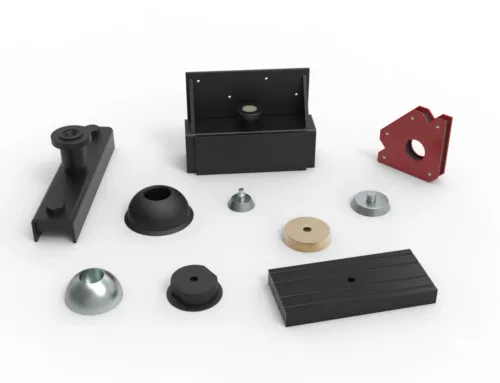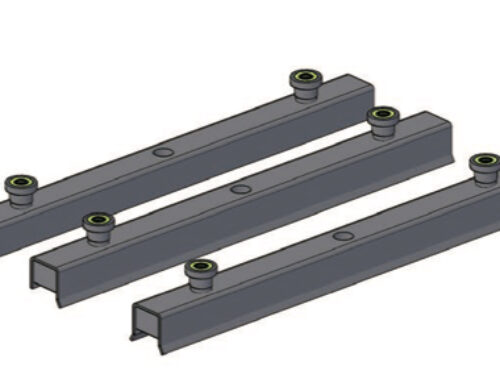Understanding Magnetic Sensors Basics and Types
Magnetic sensors detect magnetic fields and convert them into measurable electrical signals. These sensors are essential for many industrial applications, providing accurate position, speed, and current measurements without physical contact.
Key Magnetic Sensor Types
-
Hall Effect Sensors
Use the Hall effect principle, where a voltage is generated perpendicular to current flow in a magnetic field. They offer simple, cost-effective detection of magnetic fields and are widely used in automotive manufacturing and robotics.
-
Anisotropic Magnetoresistance (AMR) Sensors
Rely on changes in electrical resistance depending on the angle between the current and magnetic field. AMR sensors provide higher sensitivity than Hall sensors and are valuable for precise position and angle measurements.
-
Giant Magnetoresistance (GMR) Sensors
Utilize variations in resistance caused by electron spin alignment in layered magnetic materials. GMR sensors offer excellent sensitivity and fast response times, making them ideal for speed detection and current sensing in industrial automation.
-
Tunnel Magnetoresistance (TMR) Sensors
Operate based on electron tunneling between magnetic layers separated by an insulating barrier. TMR sensors deliver high sensitivity and low power consumption, suitable for compact, energy-efficient industrial devices.
-
Fluxgate Sensors
Measure magnetic fields by detecting the changes in magnetic permeability of a core material under an alternating magnetic field. Known for high accuracy and stability, fluxgate sensors are common in navigation and defense applications.
Industrial Relevance
Each magnetic sensor type has unique advantages tailored for specific industrial uses:
- Hall and AMR sensors provide robust solutions for motion control and position detection.
- GMR and TMR sensors excel in applications requiring high sensitivity and miniaturization.
- Fluxgate sensors are preferred where precise, low-level magnetic field measurements are critical.
Understanding these core principles helps industries select the right magnetic sensor for applications like automation, energy monitoring, and heavy machinery control.
Technological Advancements in Magnetic Sensors
Magnetic sensor technology has made significant strides recently, focusing on making sensors smaller, more sensitive, and energy-efficient. Miniaturization means these sensors now fit into tight spaces without sacrificing performance, which is essential for modern industrial setups where space is limited.
Sensitivity has improved, allowing sensors to detect even the slightest magnetic changes, enhancing precision in automation and control systems. At the same time, energy efficiency advancements reduce power consumption, making sensors more sustainable and cost-effective in the long run.
These sensors are also designed with Industry 4.0 in mind, integrating seamlessly with IoT networks. This connectivity supports real-time data collection and remote monitoring, crucial for smart manufacturing and predictive maintenance. Sensors can now communicate with other devices, improving system-wide responsiveness and reducing downtime.
Durability has been boosted to withstand harsh industrial environments. New sensor designs resist extreme temperatures, heavy vibrations, and contamination from dust or chemicals, ensuring reliable operation in places like factories, energy plants, and heavy machinery operations.
Industrial Applications of Advanced Magnetic Sensors
Advanced magnetic sensors play a big role across various industries in the U.S., helping improve accuracy and reliability in tough conditions. Here’s where you’ll often find them:
Automation and Robotics
- Used for precise position and speed detection, magnetic sensors make automation smoother and more efficient.
- They help robots know their exact location and movement, boosting productivity and safety on factory floors.
Automotive Manufacturing
- In car production, these sensors monitor motor control and detect faults early.
- They’re also key in safety systems, ensuring vehicles respond correctly during operation.
Energy Sector
- Magnetic sensors are critical for wind turbines, helping with condition monitoring and performance tracking.
- They also support smart grid systems by providing reliable data for energy distribution and management.
Heavy Machinery and Equipment
- Load measurement becomes more precise with magnetic sensors, helping prevent overloads and breakdowns.
- They’re used for wear monitoring, alerting maintenance teams before failures happen.
Aerospace and Defense
- Navigation and control systems rely on magnetic sensors for accurate positioning and orientation.
- Their reliability in harsh environments makes them perfect for defense applications where precision is non-negotiable.
These applications highlight the importance of advanced magnetic sensor technologies in improving industrial efficiency and safety across the board.
Benefits of Using Advanced Magnetic Sensors in Industry
Advanced magnetic sensors bring solid advantages to industrial environments, especially here in the U.S. where reliability and efficiency matter most. Here’s what they offer:
High Accuracy and Reliability
- Perform well even in tough conditions like extreme temperatures, vibration, and dust
- Consistently deliver precise position, speed, and load measurements
Reduced Downtime and Predictive Maintenance
- Help detect problems early through real-time monitoring
- Enable predictive maintenance, so you fix issues before they cause costly breakdowns
Cost Effectiveness
- Improve overall system efficiency, cutting energy waste
- Lower failure rates, reducing repair and replacement expenses
- Extend equipment life by preventing overload and wear
Scalability and Adaptability
- Work across multiple industries and setups—from heavy machinery to automation lines
- Easily integrate with existing industrial control and monitoring systems, including Industry 4.0 frameworks
| Benefit | Key Points |
|---|---|
| Accuracy & Reliability | Stable in harsh environments, precise data output |
| Downtime & Maintenance | Early fault detection, supports predictive care |
| Cost Effectiveness | Boosts efficiency, minimizes failures and costs |
| Scalability & Adaptability | Fits diverse industrial systems and IoT platforms |
These benefits make advanced magnetic sensors a smart choice for U.S. manufacturers looking to boost productivity while keeping operations smooth and cost-effective.
Challenges and Considerations When Implementing Magnetic Sensor Solutions
Using advanced magnetic sensors in industrial settings comes with a few challenges you need to be aware of. First, environmental factors like extreme temperatures, vibration, dust, and electromagnetic interference can affect sensor accuracy and lifespan. To handle these issues, look for sensors built with rugged materials and protective coatings, designed specifically for harsh conditions common in U.S. factories and plants.
Integration with existing systems can also be tricky. Many older machines or control systems may not be ready for easy sensor upgrades. Plan ahead by checking compatibility early, and consider working with suppliers who offer custom solutions or technical support to help with smooth installation and system integration.
When choosing a magnetic sensor supplier, focus on these key factors:
- Quality: The sensor must consistently perform under tough industrial conditions.
- Technical Support: Responsive help for setup, troubleshooting, and customization is crucial.
- Customization: The ability to tailor sensors to your specific application boosts effectiveness.
- Compliance: Ensure products meet U.S. industry standards and regulations.
Keeping these points in mind will help you overcome common hurdles and make your magnetic sensor project a success.
Why Choose NBAEM for Your Magnetic Sensor Needs
When it comes to advanced magnetic sensor solutions, NBAEM stands out with strong expertise in magnetic material supply, especially catering to industrial demands in the U.S. market. Here’s what makes NBAEM a reliable partner:
Key Strengths
| Feature | Details |
|---|---|
| Expertise in Magnetic Materials | Years of experience providing high-quality magnetic materials essential for top-performing sensors. |
| Cutting-Edge R&D | Continuous innovation focused on sensor customization and improving sensitivity, miniaturization, and durability. |
| Customization Capabilities | Tailored sensor designs to fit specific industrial applications like automation, automotive, and energy sectors. |
| Quality Assurance | Strict compliance with international standards ensuring reliable, durable, and consistent sensor performance in harsh environments. |
| Industrial Collaboration | Proven track record working with factories and heavy machinery sectors, delivering solutions that boost efficiency and reduce downtime. |
NBAEM’s combination of material expertise and advanced research capabilities makes them ideal for industrial magnetic sensor applications. Whether you need Hall effect sensors for automation systems or GMR and TMR sensors integrated into Industry 4.0 frameworks, NBAEM can provide scalable, high-quality solutions backed by real-world success stories.
Future Trends in Magnetic Sensor Technology for Industry
Magnetic sensor technology is evolving fast, especially for industrial use in the U.S. Here’s what’s shaping the future:
Emerging Sensor Technologies and Materials
New materials like advanced magnetoresistive compounds and nano-structured elements are making sensors smaller, more sensitive, and more energy-efficient. Innovations such as spintronic sensors and 3D magnetic sensors will offer better precision for complex industrial tasks—from manufacturing lines to aerospace systems.
Enhanced Connectivity and Data Analytics Integration
The push for Industry 4.0 means magnetic sensors are now designed to connect easily with IoT networks. This connectivity enables real-time data collection and remote monitoring. Advanced analytics can predict maintenance needs and optimize machine performance, reducing downtime and improving overall efficiency.
Sustainability and Eco-Friendly Advancements
Manufacturers are focusing on greener sensor technology. This includes using eco-friendly materials and designing sensors that consume less power. Sustainable production methods and longer-lasting sensors also help industries lower their environmental impact without sacrificing performance.
These trends promise magnetic sensors will become smarter, more versatile, and more aligned with U.S. industry demands for efficiency, reliability, and sustainability.





[…] Industrial Sensors: Precise magnetic patterns for sensor applications (Magnetic Sensor Technologies). […]